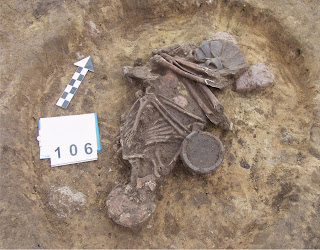Certainly people change over time, but genetic evidence is building that large folk movements are the usual catalyst for major social change.
That creates a lot problems, questions, where-froms and everything else. Here's a few things I found interesting this year...
Things Beaker people did.
We learned that throughout the entire British Beaker period to the Late Bronze Age, mummification was a normal treatment for the dead.
Disabled Central European Beakers were assisted for long periods of time and received normal treatment in burial.
Beaker women with knives, daggers and male accoutrements in Central Iberia are examined in this paper.
In Central Europe, DNA showed that a Beaker diagnostic male grave was actually a woman, or at least what we interpret to be a warrior's burial. There may be quite a few of these.
Surprisingly, it appears that a large amount of Beaker gold and copper was panned or fleeced from water, possibly through sluicing systems. In my own wild ass hypothesization I proposed that chronic mercury poisoning could be from contaminated water supplies as a result of the amalgamation process used in hydraulic mining.
Leading mining was taking place in Western Britain as well.
A few new Beakers emerge
There was Marlborough Man (actually a kid) wearing an awesome amber necklace located near a henge. A warrior's grave in Scotland near Loch Ness. The Polish region closest to Belarus has turned up quite a number of Beaker artifacts and human remains. Most interesting is the recurring, intentionally shattered and half missing pottery at this site. Seems to have been a common practice around Europe.
I failed to cover the discoveries at Perdigoes this summer. Partly because I have trouble understanding what it is, but also because it seemed that there might have been a full burial. But you can see some of what Perdigoes is churning out...
 |
| Perdigoes Research Site 2015 [Link] |
Monuments and things uncovered or analyzed
The Dartmoor Arc appears to be about as old or older than Stonehenge. A Sicilian celestial megalithic site is analyzed, Another logboat keel was discovered in Canterbury in deep mud.
A few favorite posts
The Smithy, Beakers in Hofestede' Paradigm, Corded Cultures deep genetic links, The Brachycephalic Problematic, Sailboats and Solarboats, How ceramic pottery came to the West.
Animal DNA
A few things about domestic pigs, and bees, and cattle,
People DNA
Of course this was the Mittle-Saale burials from the Haak paper and Bavarian and Czech burials from the Allentoft paper. We now have the Ratlin burials, two Vučedol period men, basically a night and day situation.
We've learned that Beakers were indeed an ethnicity with a genetic profile that extends across Europe.
Next up, 2016 and expectations for the year ahead.





















